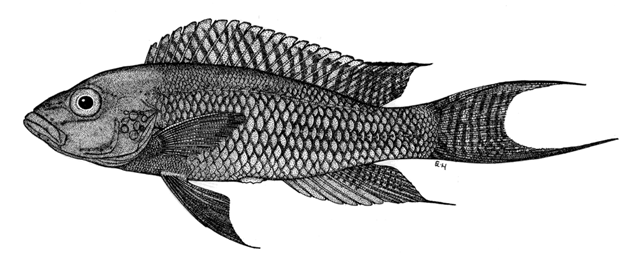| Cichlidae (Cichlids), subfamily: Pseudocrenilabrinae |
| 7.27 cm SL (male/unsexed) |
|
benthopelagic; freshwater; depth range 10 - 30 m, |
| Africa: endemic to Lake Tanganyika, only known from Cape Bangwe, Bangwe peninsula near Kigoma, Tanzania (Ref. 74422). |
|
Dorsal spines (total): 19-20; Dorsal soft rays (total): 8-10; Anal spines: 5-6; Anal soft rays: 6-7; Vertebrae: 31-31. Diagnosis: body depth 24.9–28.9% SL; cheek depth 16.7–24.1% HL; predorsal fin length 29.4–33.3% SL; caudal peduncle depth 11.2–12.8% SL; 8 upper and 6 lower canines; 6–9 gill rakers; cephalic pits present; 8-10 dorsal soft rays; 13 pectoral fin rays; 33–35 scales in longitudinal series; no scales on paired fins; no ctenoid scales on dorsal and anal fins; 2 scales between upper and lower lateral lines; 16 scales around caudal peduncle; markings on the dorsal and caudal fins not very pronounced; no markings on operculum; no conspicuous spots on scales; no bars on body; juveniles drab grey-brown (Ref. 74422).
Description: head profile in front of eye convex; premaxillary pedicel pronounced; mouth terminal, isognath, gape ends well anterior to eye; 6-9 canines in upper jaw (mode 8), 4–6 lower canines(mode 6), with 2 outer canines on both jaws enlarged; dentigerous arm of premaxilla slightly recurved; 6-9 gill rakers, slender, with black spots, decreasing in size towards anterior end of arch, often first 1-2 bifid, changes from posterior to anterior end of arch from flattened to rounded rakers; no scales on cheek; some specimens with cycloid scales on preoperculum; few scales posterior of eye, above preoperculum; 10–18 cycloid scales on operculum; few cycloid scales in supra-occipital region in most specimens (posterior to eye); fully scaled cycloid on nape; about 5–10 scales between pelvic and pectoral fin; urogenital area with ctenoid scales; flank scales ctenoid; few scales on dorsal and anal fin; no scales on pectoral and pelvic fins; caudal fin with small ctenoid scales, on 70–90 % of tail along middle rays in adults, range of scales on caudal fin increases with size; scales on outer rays range in adults up to past posterior end of middle rays; no scales on fins in juveniles, except tail which has less scales than adults; 23-30 upper lateral line scales, 21-28 canal scales in upper lateral line (median 25); 4-13 lower lateral line scales and 4–13 canal scales (median 9); 30-39 canal scales in total; scales without canal segments in between canal scales pitted; most scales anterior to canal scales in lower lateral line pitted; few specimens with 1 canal scale beyond caudal flexure; upper lateral line sometimes continued for 1–3 scales on caudal peduncle, 1 scale row further down than row containing upper lateral line on flank, leaving on peduncle only 1 scale row between upper and lower lateral lines; 1st pelvic fin ray longest; caudal fin lunate; anal fin filament on average 4.2 % longer than dorsal fin filament; dorsal fin margin concave; lower pharyngeal jaw about as wide as long; dentigerous area covered with slender, pointed, unicuspid teeth, anteriorly slightly recurved, posterior rows straight and enlarged; upper pharyngeal jaw teeth bicuspid with major cusp protracted; post-lachrymal infraorbital bone series absent; narrow suborbital groove, consisting of almost separate cephalic pits, with superficial neuromasts; papillae in pits not always visible; hardly any epidermal papillae present on body (Ref. 74422). Juveniles: no scales on fins, except tail; operculum and nape scaled; no scales on cheek and occiput (Ref. 74422).
Coloration: grey to beige; black margin on dorsal fin absent or only very thin, shorter and less conspicuous than in N. walteri; yellow-brown vertical stripes between the rays on all fins, except the pectoral; dorsal and anal fin with diagonal stripe pattern to direction of rays, about 4 stripes cross each ray; on caudal fin stripes perpendicular to rays (about 6 stripes); on pelvic fin stripe pattern more or less perpendicular to rays; in preserved specimens colour of fins not or less discernible, banded patterns visible; yellow brown vertical stripes on fins hardly noticeable when observing the fish in their habitat; pectoral fin yellow at distal end; iris light iridescent blue; blue suborbital stripe, as found in many lamprologines, in location of sensory groove; posterior margin of scales brownish (Ref. 74422).
Juveniles: brown, smallest examined specimen almost yellow (16.9mm SL); no bands on body; tail emarginate; no filaments on tail or anal and dorsal fins; pelvic fins blackish; dorsal and anal fin dark to a lesser degree, no vertical stripes on fins; margin of dorsal fin black; little spots on head (Ref. 74422). |
| Highly stenotopic, restricted to rocky habitat; occurs in exposed parts of rocky shores, with large boulders (1-2 m in diameter) on a steep slope, with some sand in between the stones, and no bivalve shell accumulations or other rubble present; presence of sand is mandatory; water with high visibility and low sedimentation rates; most common at depth between 10 and 20 m; strong site fidelity and small home range; ingests sediment and spits it out through mouth (Ref. 74422). |
|
Not Evaluated (N.E.) Ref. (130435)
|
| harmless |
Source and more info: www.fishbase.org. For personal, classroom, and other internal use only. Not for publication.

